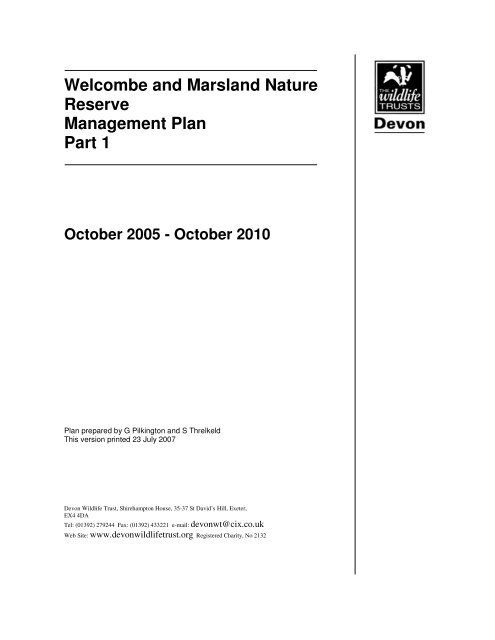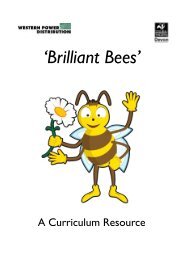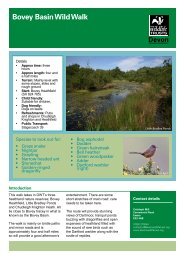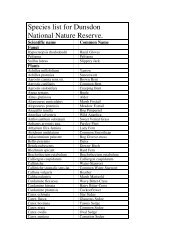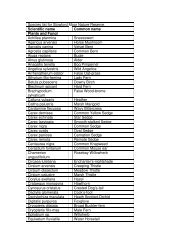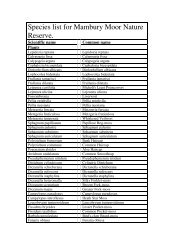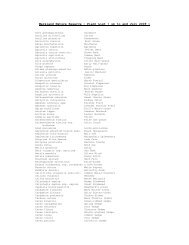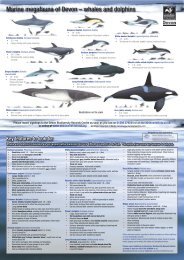Welcombe and Marsland Nature Reserve Management Plan Part 1
Welcombe and Marsland Nature Reserve Management Plan Part 1
Welcombe and Marsland Nature Reserve Management Plan Part 1
Create successful ePaper yourself
Turn your PDF publications into a flip-book with our unique Google optimized e-Paper software.
<strong>Welcombe</strong> <strong>and</strong> Marsl<strong>and</strong> <strong>Nature</strong><br />
<strong>Reserve</strong><br />
<strong>Management</strong> <strong>Plan</strong><br />
<strong>Part</strong> 1<br />
October 2005 - October 2010<br />
<strong>Plan</strong> prepared by G Pilkington <strong>and</strong> S Threlkeld<br />
This version printed 23 July 2007<br />
Devon Wildlife Trust, Shirehampton House, 35-37 St David’s Hill, Exeter,<br />
EX4 4DA<br />
Tel: (01392) 279244 Fax: (01392) 433221 e-mail: devonwt@cix.co.uk<br />
Web Site: www.devonwildlifetrust.org Registered Charity, No 2132
Policy statement:<br />
<strong>Welcombe</strong> <strong>and</strong> Marsl<strong>and</strong> <strong>Management</strong> <strong>Plan</strong> edited for DWT web site.<br />
Description:<br />
L<strong>and</strong> tenure The reserve has been built up by a number of purchases since<br />
1959.The majority of the reserve l<strong>and</strong> ( other than compartments<br />
34 (part), 35 (part) , 47,48,50 (part) <strong>and</strong> 70a ) has been<br />
covenanted with the National Trust.<br />
Total area 212ha / 520 acres<br />
Grid reference Grid Ref ss342172<br />
The reserve is now freehold owned by Devon Wildlife Trust<br />
Full scale entry into L<strong>and</strong> Registry files during 2003.<br />
Local authority Devon County Council, Torridge District Council, <strong>Welcombe</strong><br />
Parish, Hartl<strong>and</strong> Parish,Cornwall County Council, North<br />
Cornwall District Council, Morwenstow Parish<br />
<strong>Management</strong> Three exsisting on file.Active management on reserve for past 26<br />
<strong>Plan</strong><br />
years.<br />
Map coverage 1:50 000 L<strong>and</strong>ranger sheet<br />
1:25 000 Explorer OL126<br />
1:10 000<br />
190 Bude <strong>and</strong> Clovelly<br />
SS21/3 Kilkhampton<br />
SS21NW<br />
SS21NE<br />
Bounded by OS grid reference points : SS<br />
214200,213185,254178,244157,226165 <strong>and</strong> 204173 ( OS 1 :<br />
50,000 map no 190 ( Bude <strong>and</strong> Clovelly).<br />
Photographic<br />
coverage<br />
DWT nature reserves maps based on 1:2500 digital OS L<strong>and</strong>line<br />
data additionally show compartment division <strong>and</strong> location of<br />
physical features such as paths, signs, gates etc.<br />
Orthorectified digital aerial photograph taken 1999 ( DBRC under<br />
licence from DCC © Getmapping.com.)<br />
Old 1948 aerial photograph images of all reserve areas ( data file)<br />
B/W aerial photograph c1968.<br />
Slides/photos/digital images/video of species,<br />
habitats/management on reserve files.<br />
Status <strong>Part</strong> of Marsl<strong>and</strong> to Blackchurch Rock SSSI<br />
<strong>Part</strong> of Steeple Point to Marsl<strong>and</strong> Mouth SSSI<br />
<strong>Part</strong> ASOB<br />
2
Access Permit only except footpaths<br />
Rights of Way / public footpath access<br />
Legal matters This is not a legal document. Please refer to the original tenure<br />
documents before taking any decision or action which may have<br />
legal implications.<br />
DWT is legally bound by the Countryside Stewardship<br />
agreement. Any changes to the management as specified in the<br />
agreement must be agreed with the stewardship advisor first. The<br />
same applies to RES payments.<br />
Other Easter Rally : Held on Easter Saturday annually.The road down<br />
to Gooseham <strong>and</strong> up Darracott to <strong>Welcombe</strong> is part of the L<strong>and</strong>s<br />
End Trials.<br />
Shooting : Certain l<strong>and</strong>owners have retained rights to shoot over<br />
the l<strong>and</strong> which they previously owned.This applies solely to ‘pest’<br />
species.<br />
Recreation : <strong>Welcombe</strong> Mouth <strong>and</strong> car park area is very popular<br />
during the summer months.Camping is actively discouraged on<br />
reserve l<strong>and</strong> but many tents use the l<strong>and</strong> opposite the car park<br />
( different l<strong>and</strong>owner)<br />
The paths <strong>and</strong> bridleway are used by a limited number of walkers<br />
mainly during the spring / summer months.<br />
Horse riding is popular especially up <strong>and</strong> down the three official<br />
‘B’ roads passing through the reserve <strong>and</strong> along the official<br />
bridleway.<br />
3
Site description :<br />
The reserve was, until recently,owned <strong>and</strong> managed by the Royal Society for <strong>Nature</strong><br />
Conservation (RSNC -Wildlife Trusts).In 1997 the day to day running of the reserve<br />
was h<strong>and</strong>ed over to the Devon Wildlife Trust under a lease agreement.<br />
• The greater part of the reserve was acquired in the late 50’s <strong>and</strong> early 60’s by<br />
Mr.Christopher Cadbury <strong>and</strong> passed on to the RSNC over the years.<br />
• The reserve also lies within an Area of Outst<strong>and</strong>ing Natural Beauty with the<br />
Marsl<strong>and</strong> Valley being highly representative of an unspoilt coastal coombe<br />
habitat.<br />
• The first warden, who arrived on site in 1974, prepared a working management<br />
plan which formed the basis for the current work planning scheme.A <strong>Management</strong><br />
Committee was set up in 1978 to advise <strong>and</strong> assist. Scientific <strong>and</strong> monitoring work<br />
is on going throughout the seasons <strong>and</strong> includes a Common Bird Census (CBC),<br />
butterfly <strong>and</strong> dragonfly transects <strong>and</strong> listings of most other major species.There<br />
are extensive records for, amongst others, lichens,mosses,fungi, beetles <strong>and</strong><br />
hoverflies.<br />
• To date (July 07) over 18,000 records have been entered onto the ’Recorder’<br />
database.<br />
• The reserve comprises 212 hectares, of which 186 hectares occurs in the Marsl<strong>and</strong><br />
Valley <strong>and</strong> 26 hectares in the <strong>Welcombe</strong> Valley.The site was designated a SSSI in<br />
1952. In addition the reserve includes an unknown acreage of foreshore north of<br />
<strong>Welcombe</strong> Mouth for 4 kilometres, extending beyond South Hole Farm<br />
(SS219201). The boundary of the reserve is approximately 18 miles long <strong>and</strong> is<br />
very complex, mainly through following the seven separate tributary streams.<br />
• The primary interest of the reserve is as an example of a north Devon/Cornwall<br />
coombe valley with a variety of slopes, soil types <strong>and</strong> aspects <strong>and</strong> coastal area that<br />
gives rise to a similar diversity of habitats. The most important of these are the<br />
extensive areas of relatively pure oak woodl<strong>and</strong> <strong>and</strong> oak coppice, the maritime<br />
grassl<strong>and</strong> <strong>and</strong> grass heath <strong>and</strong> the alder woodl<strong>and</strong> <strong>and</strong> wet flushes in the valley<br />
bottoms.<br />
• There is approximately 36h of grassl<strong>and</strong>, 130h of woodl<strong>and</strong>, 43h of coastal habitat<br />
<strong>and</strong> 1h of open water.<br />
• The flora list is extensive with over 320+ species of flowering plant having been<br />
recorded several of these either local in their national distribution or characteristic<br />
species of the South West of Engl<strong>and</strong>.<br />
4
EVALUATION <strong>and</strong> Confirmation of important features<br />
SIZE:<br />
<strong>Welcombe</strong> <strong>and</strong> Marsl<strong>and</strong> <strong>Nature</strong> <strong>Reserve</strong> is a prime example of a Devon/Cornwall<br />
coombe valley system. Almost the whole of the Marsl<strong>and</strong> Valley water course<br />
(Marsl<strong>and</strong> Stream) is within the reserve <strong>and</strong> provides a very interesting freshwater<br />
habitat.In the case of the Marsl<strong>and</strong> Valley, in particular , the reserve is significant<br />
in that it comprises practically a complete valley system with a major watercourse<br />
<strong>and</strong> main tributaries.<br />
DIVERSITY:<br />
The reserve is extremely diverse both in terms of habitats <strong>and</strong> aspect. This<br />
diversity is being increased by habitat management.<br />
NATURALNESS:<br />
Much of the reserve is left unmanaged <strong>and</strong> has been little modified by mans’<br />
activities notably the coastline <strong>and</strong> non intervention woodl<strong>and</strong>.<br />
RARITY:<br />
Several rare species occur on reserve<br />
FRAGILITY:<br />
The valley bottom meadows are vulnerable to scrubbing over without active<br />
management.The coastal heath sections are also vulnerable to loss of diversity due<br />
to lack of grazing.<br />
TYPICALNESS:<br />
The reserve shows many features typical of the southwestern coombe valleys<br />
protected by SSSI designation.<br />
POSITION IN AN ECOLOGICAL UNIT:<br />
The reserve forms an integral part of the two SSSI’ s protecting the coastline <strong>and</strong><br />
coombe valleys along the North Devon/Cornwall coast.<br />
POTENTIAL VALUE:<br />
Active management has increased the wildlife interest in the reserve <strong>and</strong> will<br />
continue to do so.<br />
INTRINSIC APPEAL:<br />
The reserve lies within an Area of Outst<strong>and</strong>ing Beauty <strong>and</strong> the wildlife is likely to<br />
be an attraction to the general public.Locals <strong>and</strong> visitors alike comment on the<br />
beauty of the reserve <strong>and</strong> the amount of on going management being carried out.<br />
5
Evaluation for nature conservation<br />
Flora<br />
The wide variety of habitats mentioned above gives rise to an extensive <strong>and</strong> varied<br />
flora with over 320 flowering plants <strong>and</strong> 14 species of fern recorded during survey<br />
work .<br />
There is an extensive list of fungi/lichen along with many bryophyte species ( there<br />
are 141 species on the list)<br />
Though a list as yet includes no great rarities, it does include many local species <strong>and</strong> a<br />
wide selection of the characteristic species of maritime grassl<strong>and</strong>, sessile oak<br />
woodl<strong>and</strong> <strong>and</strong> wet flushes. The majority of species are representative of acid to<br />
neutral soils. The moist conditions with a narrow range of temperature allow several<br />
plants with south-western or western distributions to flourish.<br />
• Grassl<strong>and</strong>: The short turf grassl<strong>and</strong> is dominated by Red Fescue while Rye<br />
Grass, Cocksfoot <strong>and</strong> Crested Dogstail dominate the improved pasture. On the<br />
coast Kidney Vetch, Thrift, Thyme, BirdsFoot Trefoil, Spring Squill, Wild<br />
Carrot, Mouse Ear Hawkweed <strong>and</strong> Common Catsear can be found. Further<br />
inl<strong>and</strong> one can see Eyebright, Devils Bit Scabious, Betony, Centaury <strong>and</strong><br />
Purging Flax.The meadows further up the valley contain Yorkshire Fog,<br />
Common Bent, Self-Heal, Ribwort <strong>Plan</strong>tain, Heath Bedstraw, Yarrow, Ladies<br />
Smock, Knapweed <strong>and</strong> Tormentil.<br />
• Maritime Grassl<strong>and</strong>: Apart from bare ground the area is dominated by<br />
Heather, Gorse, Red Fescue <strong>and</strong> Common Bent.Other plants include<br />
Foxglove, Wood Sage <strong>and</strong> Sea Campion.On the rockiest areas English<br />
Stonecrop becomes a dominant with Bell Heather, Red Fescue, Common<br />
Catsear <strong>and</strong> Sheeps Bit.On the scree slopes Wood Vetch can be found.<br />
• Wet Flushes: Dominated by Water Forget Me Not, Lesser Spearwort, Marsh<br />
Ragwort <strong>and</strong> Ragged Robin.<br />
• Wood Pasture: Usually dominated by Ash, Sallow <strong>and</strong> Alder with Yorkshire<br />
Fog, Red Campion, Angelica, Nettle, Bugle, Moscatel, Enchanters<br />
Nightshade, Wild Daffodil, Primrose <strong>and</strong> Yellow flag.<br />
• Oak Woodl<strong>and</strong>: Oak is the dominant tree species with occasional Ash <strong>and</strong><br />
Sycamore. Hazel <strong>and</strong> Holly dominate the shrub layer. Bramble, Broad Buckler<br />
6
Fern, Ivy <strong>and</strong> Honeysuckle are the most abundant plants on the ground with<br />
Hard Fern, Male Fern, Creeping Soft Grass <strong>and</strong> Bluebell also common.<br />
Locally,more base conditions give rise to a richer ground flora with Dogs<br />
Mercury, Sanicle, Primrose <strong>and</strong> Hartstongue Fern. Spindle <strong>and</strong> Privet can be<br />
found in the shrub layer in these areas. There is considerable variation in the<br />
density of oaks between the different management units as marked by the<br />
banks which sub divide the woodl<strong>and</strong>. This points to different management by<br />
different owners in the past. The height of the canopy also varies from under 8<br />
metres in the exposed sections to 20 metres in the more sheltered valleys.<br />
• Oak-Beech Woodl<strong>and</strong>: The presence of Beech <strong>and</strong> Sweet Chestnut indicate<br />
planting sometime in the past. The dense shade cast by beech allows a sparse<br />
cover of Broad Buckler Fern, Hard Fern, Male Fern <strong>and</strong> Ivy.Mosses,<br />
especially species Polytrichum cover the ground. Beech <strong>and</strong> Holly dominate<br />
the shrub layer. This habitat occupies large areas of Gooseham, Marsl<strong>and</strong> <strong>and</strong><br />
Sherme Woods (c 18, 54 <strong>and</strong> 106). The beech shade reduces bramble growth<br />
<strong>and</strong> it allows only sparse cover of fern species.<br />
• Oak Coppice: The degenerate coppice contains Gorse, Heather, Bilberry,<br />
Tormentil <strong>and</strong> Cow Wheat.The best example of this occurs in c25 dating from<br />
just after the 2 nd World War.<br />
• Alder-Sallow Woodl<strong>and</strong>: This is characteristic of the wettest areas of the<br />
valley bottoms especially c9, 20 <strong>and</strong> 52. Alder <strong>and</strong> Sallow are dominant<br />
although both Ash <strong>and</strong> Sycamore do exist. The drier areas on the ground<br />
contain Bramble, Male Fern, Lady Fern <strong>and</strong> False Oat Grass.The wet mires<br />
have Yellow Flag, Meadowsweet, Kingcup, Hemlock Water Dropwort <strong>and</strong><br />
Golden Saxifrage.<br />
• Mixed Deciduous Woodl<strong>and</strong>: This is a secondary woodl<strong>and</strong> habitat usually<br />
dominated by Ash, Sycamore or Birch with varying amounts of Oak.The<br />
ground flora usually consists of Bracken <strong>and</strong> Bramble where the Birch<br />
dominates. Where Ash occurs, the ground flora is richer with Primrose,<br />
Sanicle, Dogs Mercury <strong>and</strong> Wild Strawberry.Hartstongue Fern generally<br />
replaces the more usual Dryopteris species.<br />
• Mixed Wet Deciduous Woodl<strong>and</strong>: This habitat occurs in the bottom of the<br />
tributary valleys <strong>and</strong> in certain parts of the main valley where the soils are not<br />
permanently saturated. Ash is the dominant tree species with some Alder <strong>and</strong><br />
Sallow.Where the light reaches the ground Primrose, Wild Daffodil, Early Purple<br />
Orchid, Valerian, Pignut, Meadowsweet, Yellowflag <strong>and</strong> Golden Saxifrage occur.<br />
7
• Elm Woodl<strong>and</strong>: Small clumps of Cornish Elm are scattered throughout the valley,<br />
usually on earth banks (especially in c19). Much of it has succumbed to the Dutch<br />
disease but suckering saplings can form thickets.<br />
• Scrub: Usually dominated by Blackthorn <strong>and</strong> Hawthorn with abundant Gorse<br />
<strong>and</strong> Bramble. Privet becomes common near the coast.<br />
• Willow Scrub: Sallow is dominant with Float Grass <strong>and</strong> Creeping Buttercup<br />
growing on the wetter soil. Southern Marsh Orchid, Ragged Robin, Marsh Thistle<br />
<strong>and</strong> Marsh Ragwort can be found in these areas.<br />
• Gorse Scrub: The cessation of some grazing has caused large areas of scrub to<br />
develop but this is managed on a rotational basis.<br />
The fauna is also very varied; the invertebrates in particular are worthy of<br />
intensive survey work. The reserve is large enough to support viable populations<br />
of mobile or vulnerable species.<br />
Fauna:<br />
Butterflies have proved to be the speciality of the reserve, with 34 species recorded in<br />
the last few years. This does not include the Large Blue which became extinct at<br />
<strong>Welcombe</strong> in the 1970s. It is the diversity of habitats that give rise to the large<br />
numbers of both species <strong>and</strong> individuals. There are around 30 to 34 species of<br />
butterfly likely to be seen on the reserve during the flight period. Most of these breed.<br />
• A butterfly recording transect has been running for 20 years helping to gain a<br />
better underst<strong>and</strong>ing of habitat requirements for each species. The first species<br />
to be recorded is usually the Brimstone followed by Small Tortoiseshell,<br />
Comma, Red Admiral, Orange Tip <strong>and</strong> Peacock.In a good migrant year more<br />
Red Admirals may drop into the reserve along with Painted Ladies.The other<br />
migrant, Clouded Yellow is often seen late on in the year round about August –<br />
October.<br />
• The coppice,woodl<strong>and</strong> glades <strong>and</strong> rides contain various species of fritillary<br />
butterflies - the Pearl <strong>and</strong> Small Pearl Bordered Fritillary can be seen from<br />
the end of May to round about mid June <strong>and</strong> in hot seasons both can have a<br />
small second brood.The Dark Green Fritillary also flies in <strong>and</strong> around the<br />
woodl<strong>and</strong> along with the Silver Washed Fritillary.The much rarer High Brown<br />
Fritillary has been recorded but in very low numbers.A very small colony of<br />
Marsh Fritillary still occurs usually on the meadows containing large<br />
amounts of devils bit scabious.<br />
8
• The Grizzled Skipper had colonised one area but hasn’ t been recorded for<br />
some while.The much commoner Small <strong>and</strong> Large Skippers can be found in<br />
many suitable sites along with Dingy Skipper.<br />
• The Holly Blue <strong>and</strong> Common Blue occur on <strong>and</strong> around the edges of the<br />
meadows together with Small Copper,Small Heath <strong>and</strong> the 'whites' - Green<br />
Veined,Small <strong>and</strong> Large.The rare Wood White is recorded occasionally ( last<br />
record 2001).<br />
The Meadow Brown is very common as is Ringlet <strong>and</strong> Gatekeeper <strong>and</strong> Marbled White<br />
numbers have increased well over the last few years.The Wall is usually located on<br />
the edge of the woodl<strong>and</strong> <strong>and</strong> Green Hairstreak is seen mainly on the coast.The<br />
Purple Hairstreak is common <strong>and</strong> found flitting over the oak trees on the sunny edge<br />
of open woodl<strong>and</strong>.The Speckled Wood frequents almost any sunny area along the<br />
tracks <strong>and</strong> paths.<br />
The reserve butterfly transect has been running for over 26 years <strong>and</strong> all species have<br />
been mapped.<br />
• Moths are well represented with over 334 species recorded.These include<br />
many of the common ones but local species like Barrett’s Marbled Coronet<br />
(Hadena luteago barrettii) <strong>and</strong> the Devonshire Wainscot (Mythimna<br />
putrescens), which is rare outside Devon <strong>and</strong> Cornwall,are present.<br />
• The rarest moth is the Scarce Blackneck (Lygephila craccae) which occurs<br />
along the coastline <strong>and</strong> is limited to this immediate area.Other species include<br />
Waved carpet <strong>and</strong> White-spotted Pinion.<br />
• The Hoverfly list st<strong>and</strong>s at 24 - these include Helophilus pendulus,Eristalis<br />
tenex,Brachypalpoides lenta,Volucella pellucens <strong>and</strong> Xylota segnis.<br />
• Dragonflies are abundant during the summer months with 18 species<br />
recorded.These include both Keeled <strong>and</strong> Black Tailed Skimmers <strong>and</strong> Black<br />
Darter.<br />
• Beetles on the lists are either common or local but the following are seen as<br />
notable:<br />
Acalles roboris,Aromia moscata,Ceutorhynchus punctiger,Chlaenius<br />
nigricornis,Hypera fuscocinerea <strong>and</strong> Judolia cerambyciformis .<br />
There are at present 161 species on the list.<br />
• Ants / the full list is Myrmica ruginodis,Formica fusca,Lasius flavus,Lasius<br />
niger,Myrmica scabrinodis,Myrmica sabuleti,Lasius alienus,Lasius<br />
mixtus,Formica cunicularia <strong>and</strong> Tetramorium caespitum.<br />
9
• The pools <strong>and</strong> ponds <strong>and</strong> surrounding areas provide habitat for large<br />
numbers of amphibians including Grass Snake,Adder,Common Lizard,Slow<br />
Worm,Common Frog,Toad <strong>and</strong> Palmate Newt.<br />
• Fish that have been found in the stream are Brown Trout, Eel <strong>and</strong> Bull<br />
Head.<br />
• Mammals are well represented with the Rabbits probably being the easiest to<br />
see along with the odd Grey Squirrel.The other species are very elusive but<br />
with careful monitoring <strong>and</strong> survey work an extensive list has been drawn<br />
up.The rarest species is the Dormouse which lives mainly in the mixed<br />
woodl<strong>and</strong> which contains hazel coppice, honeysuckle <strong>and</strong> plenty of food.The<br />
reserve specially manages certain areas for this endangered animal.There are<br />
many signs of Otter up <strong>and</strong> down the stream <strong>and</strong> survey has shown that<br />
individuals use the reserve to pass through - there has been no proof of<br />
breeding but special ’hovers’ <strong>and</strong> artificial ’holts’ have been made to further<br />
their protection.During the survey for ’spraint’ (otter droppings) many signs of<br />
Mink have also been found.<br />
Roe deer actually breed on the reserve but their numbers are very low <strong>and</strong> cause<br />
little damage to the coppice trees.The Red deer does pass through mainly in the<br />
winter months.<br />
Both the Stoat <strong>and</strong> Weasel are fairly common as is the Badger - ’setts’ in some<br />
areas are monitored on a yearly basis.All setts have been grid referenced <strong>and</strong><br />
mapped.<br />
The Fox is a regular sight on reserve <strong>and</strong> on occasions can be observed hunting<br />
for Field Mice <strong>and</strong> Short Tailed Field Voles in the fields <strong>and</strong> meadows.<br />
Other mammals include Brown Hare,Mole,Shrew,BrownRat,Hedgehog <strong>and</strong><br />
occasional Grey Seal off the coast.<br />
• Bat species include Noctule,Pipistrelle,Long Eared,Barbastelle,Lesser<br />
Horseshoe, <strong>and</strong> Daubentons.<br />
• Birds on the reserve list up to 117 with many of these actually breeding.The<br />
usual woodl<strong>and</strong> species can be seen most of the year - these include<br />
Great,Blue,Marsh,Willow,Coal <strong>and</strong> Long Tailed Tits along with<br />
Nuthatch,Treecreeper,Wren,Songthrush,Mistlethrush,Bullfinch,Blackbird <strong>and</strong><br />
Robin. The House Sparrow can sometimes be seen as can the Starling but both<br />
these birds aren’t too common unlike the Chaffinch <strong>and</strong><br />
Dunnock.Yellowhammer,Linnet,Redpoll <strong>and</strong> occasional Siskin can usually be<br />
seen on the coast <strong>and</strong> on the edge of the reserve.The Goldfinch <strong>and</strong> Goldcrest<br />
can easily be spotted <strong>and</strong> on occasions Firecrest visit during the winter.Both<br />
the Greater Spotted <strong>and</strong> Green Woodpeckers breed but the Lesser Spotted<br />
variety still remains very elusive.<br />
10
• Our summer visitors include the usual warblers found in woods -<br />
Blackcap,Garden Warbler,Chiffchaff,Willow Warbler <strong>and</strong> the occasional<br />
Grasshopper Warbler.The elusive Whitethroat <strong>and</strong> rarer Lesser Whitethroat<br />
can usually be heard more than seen usually in the scrub areas on the<br />
coast.The distinctive song of the Wood Warbler is often heard in spring <strong>and</strong><br />
one or two have stayed around to breed on occasions.<br />
• Other summer visitors include the not so common Pied Flycatcher ( the<br />
reserve usually has one or two breeding pairs) <strong>and</strong> the more common Spotted<br />
Flycatcher.The Redstart passes through but breeding is yet to be<br />
confirmed.During the early part of spring Wheatears can be seen in good<br />
numbers at both Marsl<strong>and</strong> <strong>and</strong> <strong>Welcombe</strong> Mouths as can Stonechat which<br />
does nest around the coastl<strong>and</strong> scrub.Further down on the actual rocky areas<br />
the Rock Pipit is fairly common.Its cousin,the Meadow Pipit, is also common<br />
on <strong>and</strong> above the fields <strong>and</strong> the Tree Pipit, although infrequent, can sometimes<br />
be seen <strong>and</strong> heard on the edges of the woods.Swallows,House/S<strong>and</strong> Martins<br />
<strong>and</strong> Swifts feed over the valley.<br />
• The stream has a resident pair(s) of Grey Wagtails <strong>and</strong> the Dipper also nests<br />
both at Marsl<strong>and</strong> <strong>and</strong> <strong>Welcombe</strong>.The blue flash of the Kingfisher is a common<br />
enough sight during the winter period. Herons are quite common over the<br />
reserve <strong>and</strong> along the stream.Other wintertime birds passing through include<br />
Redwing,<strong>and</strong> Fieldfare.<br />
• The crow family is well represented with Magpie,Jay,Carrion<br />
Crow,Rook,Jackdaw <strong>and</strong> the odd pair of Ravens being present all year<br />
round.The Buzzard is one member of the birds of prey which is easily seen<br />
<strong>and</strong> identified <strong>and</strong> the Sparrowhawk,Kestrel <strong>and</strong> Peregrine are all in good<br />
numbers on <strong>and</strong> around the reserve.During the summer you may even catch a<br />
glimpse of the Hobby along with the Merlin.The winter months may bring in<br />
the odd Hen Harrier along the edges of the reserve.The Tawny Owl is more<br />
often heard than seen in the woods <strong>and</strong> on occasions you could seen Barn Owl<br />
quartering the fields on the adjacent farm l<strong>and</strong>.<br />
• The coastline offers even more species including Oystercatcher <strong>and</strong><br />
Turnstone.Looking out to sea with a telescope you could see Gannet,Manx<br />
Shearwater,Fulmar,Cormorant,Shag,Common Scoter <strong>and</strong> even the odd Puffin<br />
or Guillemot.<br />
• Some old records include rare birds such as Golden Oriole,Hoopoe <strong>and</strong> Rough<br />
Legged Buzzard along with more ’unusual’ species including Mute<br />
Swan,Coot,Water Rail,Little RingedPlover,BarTailed<br />
Godwit,Whimbrel,LittleOwl,Woodlark,Nightingale <strong>and</strong> Brambling.<br />
• In recent years the reserve has recorded Little Egret,Black Crane,Yellow<br />
Browed Warbler,Quail,Jack Snipe,Arctic Skua,Little Grebe,Goshawk,Sedge<br />
Warbler <strong>and</strong> Reed Bunting.<br />
11
Summary of important features<br />
L<strong>and</strong>scape The nature reserve is a fine example of a steep sided coombe valley.<br />
Whilst a number of the coastal Coombe valleys in north Devon <strong>and</strong><br />
Cornwall are under conservation ownership, the majority of these<br />
belong to the National Trust. As well as its nature conservation duties,<br />
the National Trust has other responsibilities for access <strong>and</strong> amenity.<br />
Thus <strong>Welcombe</strong> <strong>and</strong> Marsl<strong>and</strong> is the only such area managed primarily<br />
for its wildlife interest.<br />
L<strong>and</strong> Use History The Marsl<strong>and</strong> Valley was used mainly as a source of coppice material<br />
( wood harvested in general every 20 years) <strong>and</strong> for rough grazing<br />
sheep <strong>and</strong> cattle.<br />
Public use / access,<br />
education <strong>and</strong><br />
interpretation<br />
No evidence of large scale charcoal burning but some oak may have<br />
been used in the tanning industry.<br />
.In addition the water in the stream was used to drive three mills for<br />
grinding corn <strong>and</strong> barley.<br />
The presence of beech <strong>and</strong> some sweet chestnut, larch <strong>and</strong> scots pine<br />
indicate extensive planting at some stage.A small section of c25 was the<br />
last area to be coppiced this dating from the 2 nd World War.<br />
The woodl<strong>and</strong> floor would have been more open at one stage due<br />
mainly to grazing pigs.Rough pasture <strong>and</strong> grass heath originally<br />
occupied well over half the area of the reserve <strong>and</strong> cattle/sheep grazed<br />
certain sections well into living memory.<br />
Only c6,7,15,50,63 65, 64 –66,67,68 <strong>and</strong> 71 – 79 have been grazed<br />
regularly to the present day.<br />
C66 <strong>and</strong> the upper slopes of 67 <strong>and</strong> 68 have also been used for arable<br />
crops though in the case of c66 this was well over 30 years ago.<br />
The reserve has restricted access over much of the area there are<br />
however several public rights of way on the reserve.<br />
Public interest is high mainly in the <strong>Welcombe</strong> Mouth area which is<br />
popular with surfers, locals <strong>and</strong> holiday makers <strong>and</strong> the South West<br />
Coast Path.<br />
Interpretation boards at Gooseham Mill <strong>and</strong> little Marsl<strong>and</strong> ( along with<br />
explanation leaflets since 2003)<br />
Notice board at <strong>Welcombe</strong> Mouth ( information leaflet 2005)<br />
12
Research / study Species records are held by the reserves officer on ‘Recorder’ database.<br />
Habitat<br />
Upper carboniferous<br />
Culm Measures<br />
Woodl<strong>and</strong> <strong>and</strong> scrub<br />
(c.139.5ha)<br />
Open habitats<br />
(c.72.5)<br />
Notable Species<br />
High national importance<br />
The woodl<strong>and</strong> areas of the site consists of mixed deciduous woodl<strong>and</strong>,<br />
alder <strong>and</strong> willow flushes <strong>and</strong> scrub. Full details can be found in the<br />
compartment descriptions.<br />
Sessile oak woodl<strong>and</strong> has average national importance.<br />
The wet flushes/alder carr has average regional importance.<br />
The open habitats consist of grazed areas of coastal heath <strong>and</strong> valley<br />
sides, a traditional species rich hay meadow, bracken slopes <strong>and</strong> other<br />
areas mechanically maintained by the reserve officer <strong>and</strong> assistant.<br />
Maritime heathl<strong>and</strong> has a high national importance.<br />
The maritime grassl<strong>and</strong> has a high regional importance.<br />
The unimproved grassl<strong>and</strong> in the valley meadows has a high regional<br />
importance.<br />
Species National Regional Local<br />
Wavy St John’s Wort High<br />
Portl<strong>and</strong> Spurge High<br />
Bastard Balm High<br />
Woodlouse<br />
(Halophiloscia couchii) High<br />
Pearl Bordered Fritillary High<br />
Other Fritillaries High<br />
Lesser Horseshoe Bat High<br />
Barbastelle bat High<br />
Pipistrelle bat High<br />
Dormouse High<br />
Otter<br />
Average<br />
13


